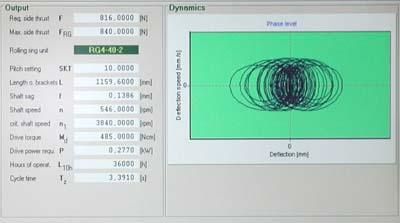
Amacoil tech support personnel simplify selection of Uhing linear drives for customers by using a proprietary software program. OEM designers and production personnel with linear motion needs may submit application data by telephone or using forms on the Amacoil web site. Based on criteria such as travel distance, weight of payload to be moved and desired ramp up time, the software enables fast calculation of required side thrust, linear travel speed, and other useful technical and performance parameters. A printout summarizes the output data and indicates the correct Uhing linear drive.
The software saves time by analyzing complex linear drive selection criteria in seconds. Those considering a Uhing traverse drive receive immediate access to useful information such as shaft rotational speed, drive torque, power requirements and shaft sag. Additional output data includes Fourier transformation analysis (showing drive displacement versus distance traveled at a constant speed) and dynamic simulation charts for visualizing shaft deflection off the centerline in relation to shaft rotation speed.
Uhing rolling ring linear drives are used in production machinery for processes such as positioning, scanning, cutting, measuring, winding and spraying. Applications exist in a variety of automated manufacturing industries including textile, automotive, wire/cable production, metrology and CNC machining. Uhing linear motion assemblies feature zero backlash and a jam-proof, smooth shaft. As the exclusive North American distributor for Uhing, Amacoil provides sales, technical support, service/repairs and parts.
Related Glossary Terms
- backlash
backlash
Reaction in dynamic motion systems where potential energy that was created while the object was in motion is released when the object stops. Release of this potential energy or inertia causes the device to quickly snap backward relative to the last direction of motion. Backlash can cause a system’s final resting position to be different from what was intended and from where the control system intended to stop the device.
- computer numerical control ( CNC)
computer numerical control ( CNC)
Microprocessor-based controller dedicated to a machine tool that permits the creation or modification of parts. Programmed numerical control activates the machine’s servos and spindle drives and controls the various machining operations. See DNC, direct numerical control; NC, numerical control.
- metrology
metrology
Science of measurement; the principles on which precision machining, quality control and inspection are based. See precision machining, measurement.
- payload ( workload)
payload ( workload)
Maximum load that the robot can handle safely.
- web
web
On a rotating tool, the portion of the tool body that joins the lands. Web is thicker at the shank end, relative to the point end, providing maximum torsional strength.
